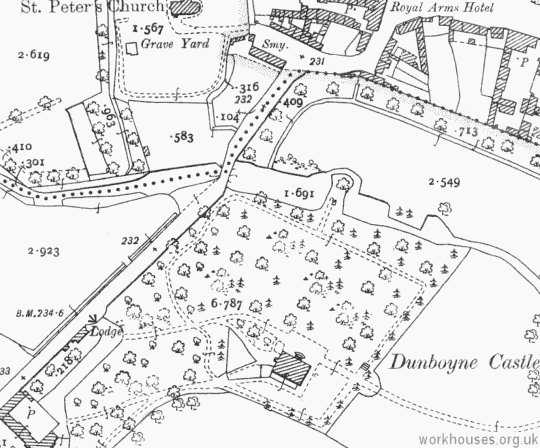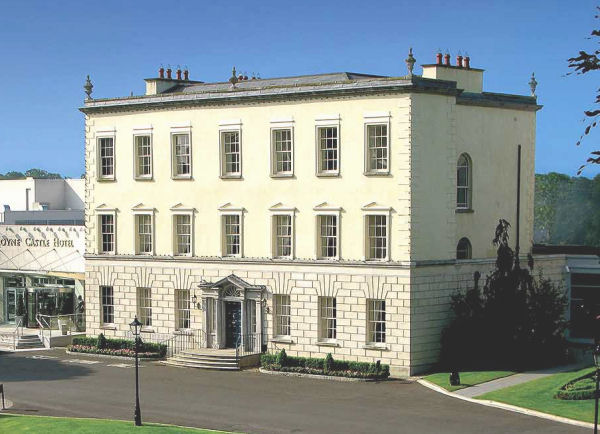Dunboyne Mother and Baby Home ('Árd Mhuire'), Dunboyne, Co. Meath, Republic of Ireland
The Mother and Baby Home at Dunboyne was opened in 1955 by the Congregation of Our Lady of Charity of the Good Shepherd, more usually known as the Good Shepherd Sisters. It resulted from a 1951 initiative by the Department of Health to remove unmarried mothers and their children from the country's County Homes, mostly former workhouse premises, which had been the main publicly-funded provision for their accommodation since Ireland's independence in 1921. Although the Department's scheme focused on children being boarded out, it accepted that there would still be a need for alternative mother and baby accommodation to be provided. Six counties in the north-east of the country — Cavan, Longford, Louth, Meath, Monaghan and Westmeath — got together to try and establish a mother and baby home. Meath appears to have taken the lead in the project, and Monaghan withdrew its participation at a fairly stage. A suitable location was eventually located in the shape of Dunboyne Castle, an eighteenth century manor house on Maynooth Road, Dunboyne, which was purchased by Meath Council on behalf of the consortium for £35,000. The £25,000 cost of altering and extending the building was covered by a government grant.
The Dunboyne Castle site is shown on the 1909 map below.

Dunboyne Castle site, Dunboyne, c.1909.
Meath County Council undertook the administration of the home on behalf of the participating councils. The role of the the home was formally stated by the Council as being a regional home for unmarried mothers and their children, who would no longer be placed in County Homes. Dunboyne would not, however, deal with first confinements, which were to be accommodated at Castlepollard. Dunboyne was not a hospital and confinements would take place in maternity hospitals in Mullingar, Trim and Dublin.
The premises originally included a reception room, drawing room, dining room, library, four bedrooms on the first floor, seven bedrooms on the second floor, and eight bathrooms. There was also a pantry, staff dining room, kitchen, scullery, larder, brush room, two servant's bedrooms, coal cellars and a boiler house. The extensive grounds included a hard tennis court and many beautiful trees. After discussions between the Sisters and the Council It was agreed that there would be accommodation for 22 'adult patients' with a possible maximum of 25 and the same number of children. There was sleeping accommodation for five or six Sisters. The Sisters agreed to supply lists of required equipment such as beds, bedding, cots, lockers and crockery and this equipment would be bought by the Council. Later purchases by the Council included a cake mixer, a potato peeler, a radiogram and records. The Council also arranged for the laundry from the home to be carried out by the firm that provided the service for the hospital in Navan.
The Good Shepherd Sisters received a weekly capitation fee for each resident at the home. In 1956, this amounted to £4 16s. 10d. for the woman and £2 8s. 5d. for a child. The order also received the income from the Castle's 55 Irish acres of lands, which were let for grazing at £12 10s. an acre.
The Sisters moved into the building on 1 June 1955 and it was blessed by the Bishop of Meath on that day. The Sisters subsequently named the home Árd Mhuire but it was more usually known as Dunboyne Mother and Baby Home. The first residents arrived on 11 October 1955.
Despite the previous intention, it seems that, from the outset, admission to Dunboyne was not confined to women from the five counties involved nor was it confined to women on second or subsequent pregnancies. By the start of 1957, the home was starting to become overcrowded. However, in the period 1955-59, the number of mothers in residence at any one time appears never to have risen above 24. The average length of stay at that time was always less than two years and from 1962 onwards it was less than a year.
An extension to the premises was built in 1963. It comprised a two-storey building of 5,000 square feet with five reception rooms, two domestic offices, six double bedrooms with wash-hand basins and two single bedrooms. This £28,000 cost was paid for by the Good Shepherd Sisters.
At the end of March 1964,, there were 20 mothers and 18 children in residence. Of the 21 children discharged during the previous 12 months, 15 were adopted. As mothers were tending to stay for shorter periods, their overall numbers increased significantly. However, the numbers of children in residence decreased as the practice developed of placing them into foster care directly from the maternity hospital rather than first taking the babies to Dunboyne. In the year ending 31 March 1973, there were 31 mothers resident in Dunboyne and a total of 131 had been admitted over the previous year. Private patients also featured in the home's intake, with eleven being admitted in the period 1965-68.
The Sisters had daily Mass in the convent but there was no obligation on the women to attend and, in general, they did not attend. The residents' meals were prepared by the Sister in charge of the kitchen with help from some of the residents. The kitchen garden provided fresh fruit and vegetables.
Each resident usually had some light cleaning to do each day, unless they had medical reasons not to do this. The heavy housework was carried out by a lay staff member. The large laundry items (bed linen, towels) were sent weekly to a commercial laundry. There was a household launderette for the women's personal washing.
in the 1970s, life at the home became less institutional. Boyfriends started visiting and the 'girls' went off for weekends. Family, friends were welcome to visit on the premises. There were no standard visiting hours. There was no set getting up time or going to bed time. The residents decided for themselves and bedtime was significantly related to the TV schedule. There was a pay phone and the residents were free to use it. There was no question of anyone opening someone else's post. The residents all wore their own clothes; there was no uniform.
In May 1981, the Department of Health noted that Dunboyne had 29 beds and accommodates mainly very young unmarried mothers, many of them schoolgirls. The occupancy rate was very high. The girls stayed an average of three months, were delivered in one of the Dublin Maternity Hospitals and, in most cases, were discharged directly from the hospital. They or their babies seldom returned to Dunboyne. The Department suggested that any babies not kept by their mothers and not adopted probably went to St Clare's, Stamullen.
The Department's inspector, Miss Reidy, visited Dunboyne. She noted that the nursery was seldom occupied by infants. The other accommodation included a residents' TV room, a smoke room, a record (music) room, a dining room, two parlours for girls' visitors, a surgery which was used once weekly by the dispensary doctor and more often by the public health nurse, an office for the social worker, a kitchen with scullery area, store cupboard and cold room, a milk kitchen (which was seldom used), three staff bedrooms with bathroom facilities, a launderette for the residents' personal clothes, and an occupational therapy room. There were five bathrooms, nine toilets and a toilet for visitors. There were two cooks (one for weekdays and one for weekends), one domestic, a full-time and a part-time (summer only) gardener. These were all secular staff. There were five members of the Good Shepherd Sisters, an administrator, a midwife, a social worker, a nursery nurse and a receptionist. There were six part-time paid teachers and a part-time voluntary worker who supervised studies. She observed that the number of schoolgirls was increasing each year. In 1980, Department of Education had agreed to recognise the institution as an examination centre to accommodate 14 entrants for the Intermediate and Leaving Certificate examinations. The Director of Community Care considered that occupational therapy was necessary. 'Card packing for Union greetings, Greenmount estate and Harolds Cross is undertaken, knitting and sewing and a weekly lecture from the Board's consultant dietitian on appropriate subjects is given.' Miss Reidy said that most mothers were discharged directly from Holles Street; the few who returned to Dunboyne stayed for only two to three days on average. Infants were seldom brought back. Dunboyne was primarily, therefore, an antenatal centre. Miss Reidy concluded that it was 'comfortable, well run and a relaxed homely atmosphere prevails. All accommodation is clean and well kept and all day living-units are nicely appointed. I am much impressed with the work carried out here.'
By the late 1980, the Sisters were experiencing increasing financial difficulties due the the decline in numbers using the home. After consulting various with a wide variety of individuals involved in the social care system, the Sisters had concluded that the home was no longer meeting the needs of single pregnant girls. In order to address the situation, they would proposed to offer services to two groups: school-age girls and homeless older girls, eight to ten in each category. This would require moving to smaller city-base premises to be closer to maternity hospitals, educational courses and means of socialising.
After extensive discussions with the North Eastern Health Board and the Department, it was decided that Dunboyne would close in June 1991. The last two residents left in February of that year. The buildings now form part of the Dunboyne Castle Hotel.

Former Mother and Baby Home, Dunboyne.
In January 2021, Ireland's Mother and Baby Homes Commission of Investigation made its final report, which included an examination of the operation of the Dunboyne Home. Statements from former residents were generally very positive about the home and indicated that it provided comfortable, warm accommodation and that the residents were well looked after physically. The younger women were provided with educational opportunities from the 1980s. A letter in the home's files, written in the 1990s by a woman who was there in the 1970s and who kept her baby, stated that she was very grateful for the time spent in Dunboyne; she described it as 'a refuge, a sanctuary, a place of tranquillity, stability, rest and safety'. Some former residents did make complaints about the adoption process. In general, the adoptions were arranged by adoption societies and not directly by Dunboyne. However, the Sisters in Dunboyne did talk to the residents about adoption and clearly did encourage them to place the babies for adoption. Many of the mothers clearly felt that they had no choice about adoption, pressure for adoption was also coming from their families.
Records
Note: many repositories impose a closure period of up to 100 years for records identifying individuals. Before travelling a long distance, always check that the records you want to consult will be available.
- Tusla — Child and Family Agency, The Brunel Building, Heuston South Quarter, Saint John's Road West, Dublin 8. D08 X01F
Bibliography
- Nicolson, Jill Mother and Baby Homes: a survey of homes for unmarried mothers (1968, Allen & Unwin)
- Redmond, Paul Jude he Adoption Machine: The Dark History of Ireland's Mother and Baby Homes and the Inside Story of How Tuam 800 Became a Global Scandal
Links
Except where indicated, this page () © Peter Higginbotham. Contents may not be reproduced without permission.


